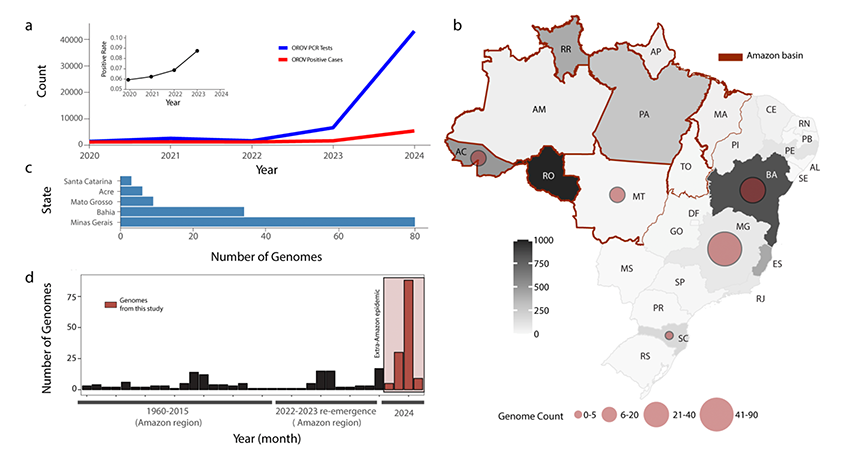Collaborators: Felipe Campos de Melo Iani, Felicidade Mota Pereira, Elaine Cristina de Oliveira, Janete Taynã Nascimento Rodrigues, Mariza Hoffmann Machado, Vagner Fonseca, Talita Emile Ribeiro Adelino, Natália Rocha Guimarães, Luiz Marcelo Ribeiro Tomé, Marcela Kelly Astete Gómez, Vanessa Brandão Nardy, Adriana Aparecida Ribeiro, Alexander Rosewell, Álvaro Gil A. Ferreira, Arabela Leal e Silva de Mello, Brenda Machado Moura Fernandes, Carlos Frederico Campelo de Albuquerque, Dejanira dos Santos Pereira, Eline Carvalho Pimentel, Fábio Guilherme Mesquita Lima, Fernanda Viana Moreira Silva, Glauco de Carvalho Pereira, Houriiyah Tegally, Júlia Deffune Profeta Cidin Almeida, Keldenn Melo Farias Moreno, Klaucia Rodrigues Vasconcelos, Leandro Cavalcante Santos, Lívia Cristina Machado Silva, Livia C. V. Frutuoso, Ludmila Oliveira Lamounier, Mariana Araújo Costa, Marília Santini de Oliveira, Marlei Pickler Dediasi dos Anjos, Massimo Ciccozzi, Maurício Teixeira Lima, Maira Alves Pereira, Marília Lima Cruz Rocha, Paulo Eduardo de Souza da Silva, Peter Rabinowitz, Priscila Souza de Almeida, Richard Lessels, Ricardo T. Gazzinelli, Rivaldo Venâncio da Cunha, Sabrina Gonçalves, Sara Cândida Ferreira dos Santos, Senele Ana de Alcântara Belettini, Silvia Helena Sousa Pietra Pedroso, Sofia Isabel Rótulo Araújo, Stephanni Figueiredo da Silva, Wes Van Voorhis, Darren P. Martin, Edward C. Holmes, Tulio de Oliveira, José Lourenço, Luiz Carlos Junior Alcantara, Marta Giovanetti
Summary: The Oropouche virus, initially detected in Trinidad and Tobago in 1955, has been historically confined to the Amazon Basin. However, since late 2022, it has been reported elsewhere, from northern Brazil to urban centers in Bolivia, Colombia, Cuba, and Peru. In this report we describe the doubling of publicly available full genomes by generating 133 new entries. We show how the virus evolved via recombination and how it rapidly spread across multiple states in Brazil, causing the largest outbreak ever recorded outside the Amazon basin including the first ever detected deaths. This work highlights the need for heightened epidemiological and genomic surveillance and the implementation of adequate responses in order to avoid Oropouche becoming another widespread arboviral public health threat.
Background: The Oropouche virus was first identified in 1955 in Trinidad and Tobago and later found in Brazil in 1960. Historically, it has been reported to have caused around 30 outbreaks, most of which within the Amazon Basin where it circulates among forest animals, but also in urban areas where it is known to be transmitted by the midge Culicoides paraensis. Recently, Brazil has seen a surge in cases, with 6000 reported by mid-2024 alone. Methods: In a collaboration with Central Public Health Laboratories across Brazilian regions, we integrated epidemiological metadata with genomic analyses of recently sampled cases. This initiative resulted in the generation of 133 whole genome sequences from the three genomic segments (L, M, and S) of the virus, including the first genomes obtained from regions outside the Amazon and from the first ever recorded fatal cases.
Findings: All of the 2024 genomes form a monophyletic clade in the phylogenetic tree with sequences from the Amazon Basin sampled since 2022. Our analyses reveal a fast and clear pattern of north-tosouth viral movement from the Amazon Basin into historically non-endemic regions. We identified 21 recombinant events, but it remains unclear if such genomic changes mirror potential adaptations and the emergence of new viral phenotypes of public health importance.
Interpretation: Both the recent rapid spatial expansion and the first reported fatalities associated with Oropouche underscore the importance of enhancing surveillance at both national and continental levels. Without any obvious changes in the human population over the past 2 years, it remains likely that either alone or in combination, viral adaptation, deforestation and climate change trends in the recent past may have propelled the Oropouche virus beyond the Amazon Basin.
Publication Date: 2024-08-04
Journal: medRXiV
Download full article: MEDRXIV-2024-311415v1-Iani

